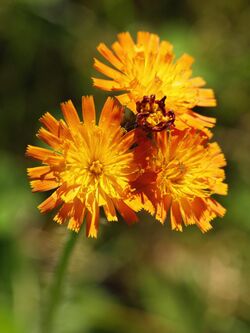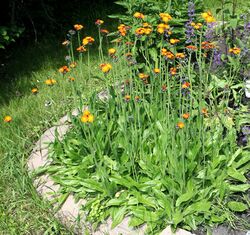Biology:Pilosella aurantiaca
| Pilosella aurantiaca | |
|---|---|

| |
| Scientific classification | |
| Kingdom: | Plantae |
| Clade: | Tracheophytes |
| Clade: | Angiosperms |
| Clade: | Eudicots |
| Clade: | Asterids |
| Order: | Asterales |
| Family: | Asteraceae |
| Genus: | Pilosella |
| Species: | P. aurantiaca
|
| Binomial name | |
| Pilosella aurantiaca | |
| Synonyms[3] | |
| |
Pilosella aurantiaca (fox-and-cubs,[4]:758 orange hawkweed,[5]:208 devil's paintbrush,[6]:324 grim-the-collier) is a perennial flowering plant in the family Asteraceae that is native to alpine regions of central and southern Europe, where it is protected in several regions.[citation needed]
Description
It is a low-growing plant with shallow fibrous roots and a basal rosette of elliptical to lanceolate leaves 5–20 centimetres (2.0–7.9 in) long and 1–3 centimetres (0.39–1.18 in) broad.[7] All parts of the plant exude a milky juice. The flowering stem is usually leafless or with just one or two small leaves. The stem and leaves are covered with short stiff hairs (trichomes), usually blackish in color. The stems may reach a height of 60 centimetres (24 in) and have 2–25 capitula (flowerheads), each 1–2 1⁄2 cm diameter, bundled together at the end of short pedicels. The flowers are orange, almost red, which is virtually invisible to bees, yet they also reflect ultraviolet light, increasing their conspicuousness to pollinators.[8] The flowers are visited by various insects, including many species of bees, butterflies, pollinating flies.[8][9] The flowers themselves come in a range of colors from a deep rust-orange to a pure yellow and often show striking gradients of color. In the UK, it flowers in June and July.[9] After flowering, it produces seedpods with a pappus of white or pale brown hairs.[10]
The plant propagates through its wind-dispersed seeds, and also vegetatively by dividing the stolons and shallow rhizomes in autumn or spring.[10]
Taxonomy
The Latin specific epithet aurantiaca means 'orange', referring to the usual colour of the blooms.[11] The common name of fox-and-cubs is due to the appearance of the open flowers (the fox) beside the flower buds (the cubs).[9]
Distribution
Pilosella aurantiaca is native to parts of Europe (central, eastern, northern, southeastern and southwestern). It is widely naturalized elsewhere, including other parts of Europe such as Great Britain and Ireland, Central Asia, Canada, many states in the United States, Japan and New South Wales.[3]
Cultivation and uses
P. aurantiaca is widely grown as an ornamental plant in gardens for its very decorative flowers. It is often used in wildflower gardens because its bright orange flowers are highly attractive to a wide array of pollinators.[12]
Invasive weed
Orange hawkweed (Pilosella aurantiaca) is currently the only hawkweed considered regionally invasive in areas of British Columbia, Canada . It is considered invasive in the East Kootenay, Central Kootenay, Columbia-Shuswap, Thompson-Nicola, Bulkley Nechako, and Cariboo Regional Districts. Invasive hawkweed can replace native vegetation in open, undisturbed natural areas such as meadows, reducing forage and threatening biodiversity.[13] In Victoria and NSW, Australia , hawkweed species are declared as "State Prohibited Weeds" and are controlled under The Bio Security Act 2015. Orange hawkweed is also considered an invasive species in some states in the United States , such as Wisconsin and Minnesota.[14][15] Currently there are several eradication programs operating (often employing volunteers) to locate, prevent the spread of and eradicate any Pilosella or Hieracium plants.
References
- ↑ Bräutigam, S; Greuter, W (2007). "A new treatment of Pilosella for the Euro-Mediterranean flora". Willdenowia 37 (1): 123–137. doi:10.3372/wi.37.37106.
- ↑ Schultz, FW; Schultz-Bipontinus, CH (1862). "Pilosella als eigene Gattum aufgestellt". Flora (Separatabdruck) 45: 417–441. https://books.google.com/books?id=GRciAQAAMAAJ&pg=PA1.
- ↑ Jump up to: 3.0 3.1 "Pilosella aurantiaca L.) F.W.Schultz & Sch.Bip.." (in en). Royal Botanic Gardens, Kew. http://www.plantsoftheworldonline.org/taxon/238000-1.
- ↑ Stace, C. A. (2019). New Flora of the British Isles (Fourth ed.). Middlewood Green, Suffolk, U.K.: C & M Floristics. ISBN 978-1-5272-2630-2.
- ↑ Peterson, Roger Tory; McKenny, Margaret (1968). A Field Guide to Wildflowers of Northeastern and North-Central North America. Houghton Mifflin Company Boston. ISBN 0-395-18325-1. https://archive.org/details/fieldguidetowild00pete.
- ↑ Venning, Frank D. (1984). A Guide to Field Identification Wildflowers of North America. New York: Golden Press. OCLC 301214740.
- ↑ Blanchan, Neltje (2005). Wild Flowers Worth Knowing. Project Gutenberg Literary Archive Foundation.
- ↑ Jump up to: 8.0 8.1 Van Der Kooi, C. J.; Pen, I.; Staal, M.; Stavenga, D. G.; Elzenga, J. T. M. (2015). "Competition for pollinators and intra-communal spectral dissimilarity of flowers". Plant Biology 18 (1): 56–62. doi:10.1111/plb.12328. PMID 25754608. https://research.rug.nl/en/publications/caee8d0d-9724-4056-9d45-93162a5a7afc.
- ↑ Jump up to: 9.0 9.1 9.2 "Pilosella aurantiaca" (in en). https://www.gardenersworld.com/plants/pilosella-aurantiaca/.
- ↑ Jump up to: 10.0 10.1 "Pilosella aurantiaca | fox and cubs Herbaceous Perennial/RHS Gardening" (in en-gb). https://www.rhs.org.uk/plants/65455/pilosella-aurantiaca/details.
- ↑ Harrison, Lorraine (2012). RHS Latin for Gardeners. United Kingdom: Mitchell Beazley. ISBN 978-1845337315.
- ↑ "Meadow Mat Wildflower Species: Fox and Cubs". Meadow Mat Wildflower Matting. https://www.meadowmat.com/wildflower-species/fox-and-cubs. Retrieved 27 January 2019.
- ↑ "Invasive Species Council of BC". https://bcinvasives.ca/invasive-species/identify/invasive-plants/hawkweeds. Retrieved 27 January 2019.
- ↑ "Online Virtual Flora of Wisconsin - Hieracium aurantiacum". http://wisflora.herbarium.wisc.edu/taxa/index.php?taxon=3848.
- ↑ "Orange hawkweed (Hieracium aurantiacum)" (in en). https://www.dnr.state.mn.us/invasives/terrestrialplants/herbaceous/orangehawkweed.html.
Wikidata ☰ {{{from}}} entry
 |


